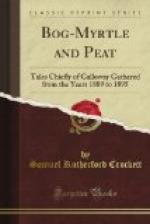Richard Cameron was by nature an early riser, a gift to thank God for. Many a Sabbath morning he had seen the sun rise from the ivy-grown arbour in the secluded garden behind the old whitewashed kirk. It was his habit to rise early, and, with the notes of his sermon in hand, to memorise, or “mandate,” them, as it was called. So that on Sabbath, when the hill-folk gathered calm and slow, there might be no hesitation, and he might be able to pray the Cameronian supplication, “And bring the truth premeditated to ready recollection”—a prayer which no mere “reader” of a discourse would ever dare to utter.
But this was not a morning for “mandating” with the minister. It was the day of his pastoral visitation, and it behoved one who had a congregation scattered over a radius of more than twenty miles to be up and doing. The minister went down into the little study to take his spare breakfast of porridge and milk. Then, having called his housekeeper in for prayers—which included, even to that sparse auditory, the exposition of the chapter read—he took his staff in hand, and, crossing the main street, took the road for the western hills, on which a considerable portion of his flock pastured.
As he went he whistled, whenever he found himself at a sufficient distance from the scattered houses which lined the roads. He was everywhere respectfully greeted, with an instinctive solemnity of a godly sort—a solemnity without fear. Men looked at him as he swung along, with right Scottish respect for his character and work. They knew him to be at once a man among men and a man of God.
The women stood and looked longer after him. There was nothing so striking to be seen in Galloway as that clear-cut, clean-shaven Greek face set on the square shoulders; for Galloway is a country of tall, stoop-shouldered men—a country also at that time of shaven upper lips and bristling beards, the most unpicturesque tonsure, barring the mutton-chop whisker, which has yet been discovered. The women, therefore, old and young, looked after him with a warmth about their hearts and a kindly moisture in their eyes. They felt that he was much too handsome to be going about unprotected.
Notwithstanding that the minister had a greeting in the bygoing for all, his limbs were of such excellent reach, and moved so fast over the ground, that his pace was rather over than under four miles an hour. Passing the thirteen chimneys of the “Lang Raw,” he crossed Dee bridge and bent his way to the right along the wide spaces of the sluggish river. The old fortress of the Douglases, the castle of Thrieve, loomed up behind him through the wavering heat of the morning. Above him was the hill of Knockcannon, from which Mons Meg fired her fatal shots. The young minister stood looking back and revolving the strange changes of the past. He saw how the way of the humble was exalted, and the lofty brought down from their seats.
“Some put their trust in horses, and some in chariots,” said the minister, “but we will trust in the Lord.”




